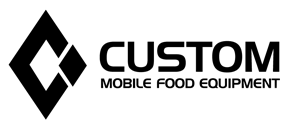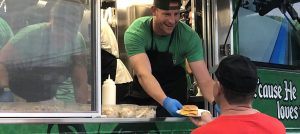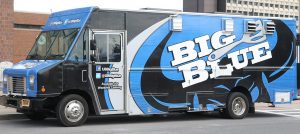It’s easy to overlook a business name as generic as Custom Sales and Service Inc.
Driving past the Hammonton factory’s nondescript facade may be even easier.
But it’s hard to ignore a national leader, especially one whose fleet of handmade food trucks, kiosks and carts reaches the corporate lots all over the Delaware Valley, every university on the East Coast, disaster sites across the country, and, oh, Disney World.
“We’re actually the largest manufacturer in the U.S. to do everything (related to mobile catering equipment),” says David Kyle, the company’s director of marketing and sales.
“We’re really the only manufacturer in the U.S. that builds everything.”
From ice cream trucks to hot dog carts, a procession of foodie floats has been leaving the 50,000-square-foot garage since Bill Sikora, Kyle’s grandfather, founded it in 1956. But the wheels to the family business are cranking even quicker these days, churning out the eco-friendly GEM (Global Electric Motorcars) food cars and food trailers for movie and TV sets.
The mobile-food industry doesn’t show signs of stopping, says Guy Selph, director of specialty vehicles and husband to owner Lynda Sikora.
“Last year was the best year of production since the first half of 2007,” Selph says. “And this year is starting off better than last.”

The company’s vehicles are relied on by entrepreneurs and a generation of food connoisseurs.
“More and more people are going into business for themselves,” says Kyle, who estimates the company sold 50 food trucks in 2014. “You’ve always had the big corporate clients, the colleges, the larger private individuals, but now you’re having more of the mom-and-pop guys who are going into the industry so it’s definitely driving the food-truck industry into a billion dollar industry.”
Bill Sikora had a hand in the food industry since he was an 8-year-old shaving blocks of ice and selling snow cones in Camden for 2 or 3 cents each. His bank account and business acumen grew in adulthood when he opened several diners in the Haddon Township area, including the Collmont Diner in Cherry Hill (now Amy’s Omelette House).
But the well-known restaurateur sold every property to focus on the one business he thought was really going places, says Lynda Sikora, who has ran Custom Sales and Service since her 92-year-old father retired and moved to Florida.
A few factors are steering modern entrepreneurs past the idea of opening a restaurant and to food trucks.
“You can go into a food-truck business for about 15 percent of what a brick-and-mortar would cost,” Selph says. “… You can’t even buy a location in an empty building in Philadelphia for a million.”

A used food truck with brand new equipment starts at $70,000 and a new truck starts at about $125,000, Sikora says. Not beginning their business buried in debt is just one reason food truck owners are in a better position than restaurateurs.
“You’re taking the food to where the people are. In a diner, you’re waiting for the people to come to you,” Sikora adds.
“If I open a diner in a location and it doesn’t work, I’m stuck there. But in a food truck I can go many different places. You can do catering, corporate picnics, birthday parties — that can all be done out of a food truck. We still need those brick and mortar locations but food trucks, there’s many different opportunities.”
Kyle was more familiar with another type of truck in Florida, as the state’s youngest fire marshal. He rose to fire chief while working weekends for Custom Sales and Service, often flying across the country to lead trade shows and meet with corporate clients.
He left the fire department two years ago and jumped aboard the family business.
“My mom took over for the grandfather and I’m coming in for her,” Kyle says. “She still runs the business. I’m learning more and more about the business.”
He’s also learned about show business, following tractor trailers to movie and TV show sets to ensure smooth operation.
“Pretty much every studio in New York, our trucks are on their sets,” Sikora says, including “Elementary” and “Person of Interest” most recently.
As the primary vendor for the Salvation Army, its mobile trailers also come to the aid of the victims and first responders of natural disasters such as Hurricane Katrina and the 2013 tornado in Oklahoma City.
“The Salvation Army, particularly down South where they have hurricanes and tornadoes on a regular basis, can have some of these departments there from three days to six months,” says Selph, who heads the company’s disaster-relief division.
Children may be more impressed to know the company’s kiosks and food trucks service area theme parks like Six Flags Great Adventure, Dorney Park and Hershey Park, as well as the granddaddy of all theme parks.
“You can go into Disney (World), see all the carts and know they all come from that town in Hammonton,” Sikora says.
Food trucks have come a long way since Kyle’s grandfather wheeled them off his lot, with many equipped with flatscreen LED screens, LED lighting underneath, satellite TV, and a point-of-sales system where “you can walk up, swipe your credit card and order,” Kyle says.Beside the standard welding and wiring, its staff of about 50 is adept at woodwork, upholstery, paint, fiberglass, refrigeration and more.
Perhaps even more impressive, “everything is done in-house,” Kyle says.
Well, not everything. When a truck is completed, it goes to Always A Good Sign in West Berlin, where store owner Sean Flanagan customizes it with a graphic wrap in his airtight facility, then returns it to its Hammonton home with a dazzling new design.
The engineers are happy to either design a food truck or follow a client’s directions, Kyle says.
“It’s everybody’s imagination,” Kyle says. “We’ve built every different thing, every different size. We’ve put bathrooms on food trucks.”
But bathrooms aren’t customers’ concern — sinks and hand soap are. Lynda Sikora says trucks have been losing their unsanitary stigma over the last decade thanks to more rigid health inspections.
“A lot of them didn’t meet health-code regulations,” Sikora says of food trucks from a decade ago. “They always had health-code regulations, but they weren’t as strict about them as they are now. Now they make them go for that food handling course, they make them really have the three-compartment sink, the hand sink, the waste water (holding tank).”
Competition also has a way of making people clean up their act. With an estimated 3 million food trucks and 5 million food carts in America, there’s plenty of healthy competition but even more customers who prefer increasingly unique gourmet cuisine at budget-conscious prices.
“It’s not going to go away because we’re in the foodie generation,” Sikora says. “… They want good food. They’re going to demand different things, so that’s who the food trucks are catering to, the foodies who are out there now.”






